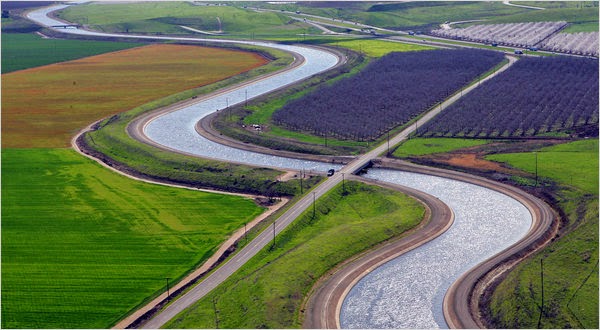All Things Considered:
California is America's agricultural state, but its vineyards, orchards and vegetable fields don't actually get enough rainfall to grow a crop. Some of those fields — notably the "salad bowl" of the Salinas Valley — get their water from wells.Sure, it's frustrating as Hell when I mow my hay and bet against the weatherman, and he ends up being right, but I feel much better about the world's most productive rain-fed agricultural region than I would farming a desert, no matter how much engineering goes into it. However, the ins and outs of western water law are a perfect example of warped markets and bad incentives. $30 an acre-foot is more than 10,000 gallons for a dollar. Compare that to that bottle of water you bought at the gas station.
The majority, though, depend on water from , mainly from melting snow in the mountains. Dams capture it, pumps and canals distribute it, and lawyers argue over who gets to use it.
Some end up with much more water than others.
Let's start with one of the fortunate ones: Allen Peterson, who grows almonds near the city of Turlock, Calif. A concrete-lined canal full of water runs right past his orchards. "The water's coming from Lake Don Pedro, on the Tuolumne River," Peterson explains.
The started building dams on the Tuolumne more than a century ago. Now, every farm in this district gets a share of the lake's water. This year, it's less than usual but still enough to grow a crop of almonds.
That secure source of water is as much a part of Peterson's farm as the land itself. It's also a family legacy. "My grandfather, and even people before him, built this irrigation system," Peterson says. "He scraped canals, built this thing up. They sacrificed a lot to have this irrigation system. And our land prices have reflected that ever since."
His land is valuable. The water itself, though, comes cheaply. Peterson is paying the district just under $30 this year for each acre-foot of water. (That's enough water to cover an acre of land to a depth of 1 foot.)
Meanwhile, there are farmers not far away, on the other side of California's Central Valley, who've been paying much, much more.
"We've had water that's sold for upwards of $2,000 an acre-foot," says Sarah Woolf, a farmer and water consultant in Five Points, southwest of Fresno. "It was horrible."
Woolf and I are standing in an almond orchard that's alive thanks to that expensive water.
It's part of the , which came late to the California water party. It tapped into the statewide system of aqueducts just 50 years ago. So under California's water laws, when there's not enough water for everyone, farmers here are the first to be cut off.
They were cut off this year. The owner of this orchard turned to Woolf to help him buy enough water to keep these trees alive. Woolf located a few farmers outside the Westlands area with rights to water that they were willing to sell.
The actual transfer of water was just a matter of aquatic bookkeeping. The sellers gave up their rights to draw some water from California's aqueducts, and this farmer was able to use that amount of water instead.
But this kind of exchange doesn't happen very often. In some places, it's banned. The Turlock Irrigation District, for instance, doesn't allow farmers to sell any of their $30 water outside the district.
This is why farmers are paying such wildly different prices. The water's not allowed to move.

No comments:
Post a Comment